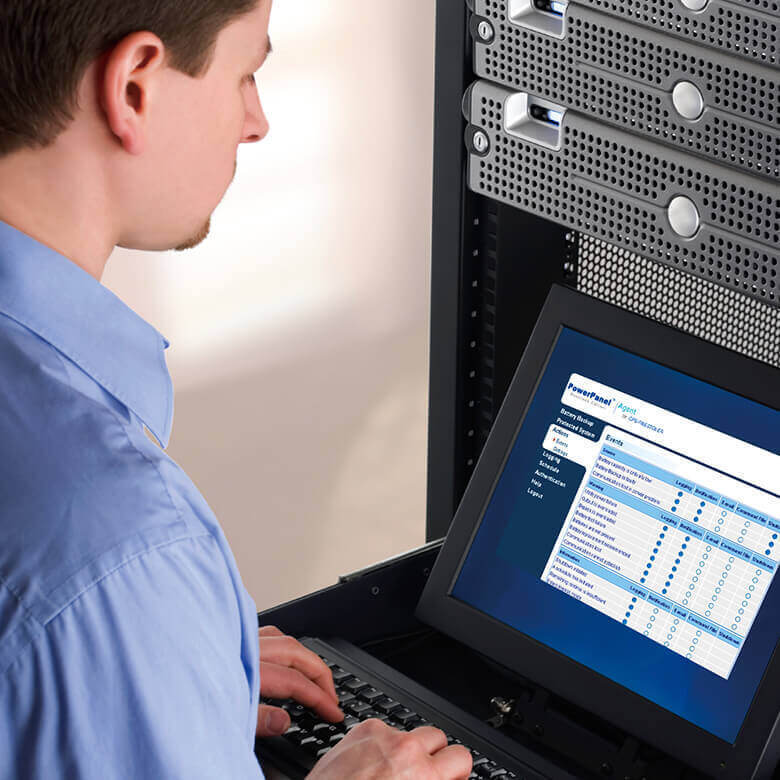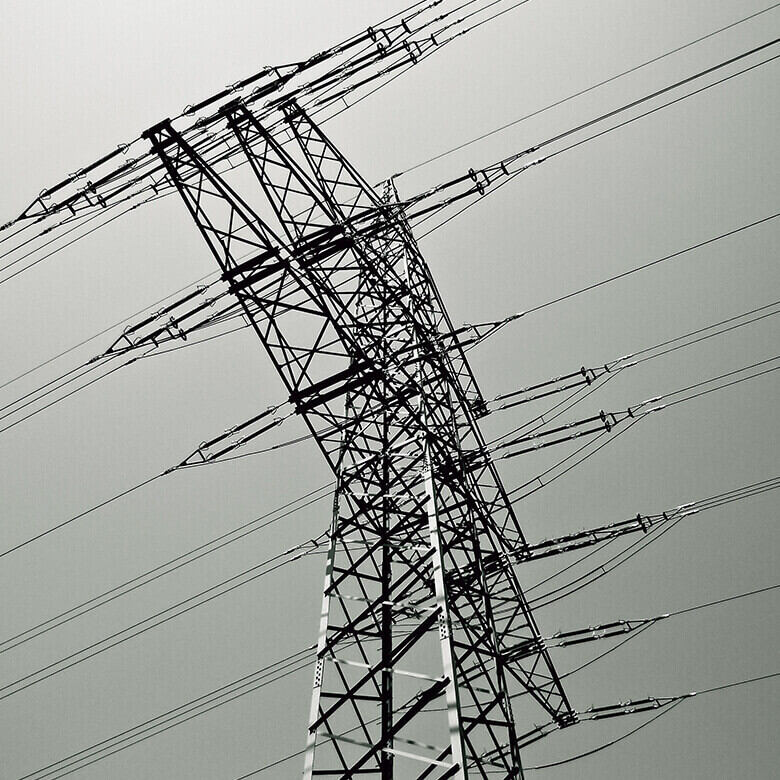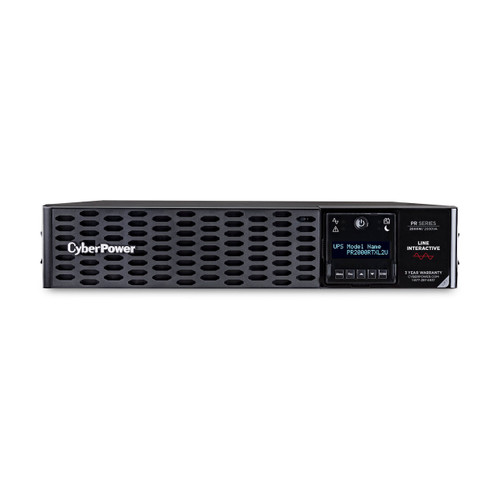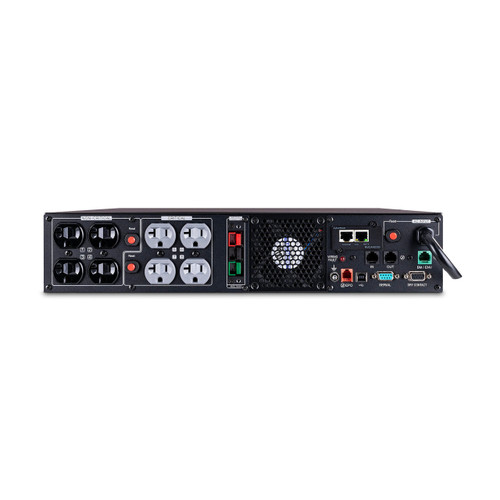CyberPower PR1500LCD | Smart App Sinewave UPS Series
Product Overview
A mini-tower UPS with line interactive topology, the CyberPower Smart App Sinewave PR1500LCD provides battery backup, power protection (using sine wave output), and surge protection for corporate servers, department servers, storage appliances, network devices, and telecom installations requiring Active PFC power source compatibility. The PR1500LCD uses Automatic Voltage Regulation (AVR) to correct minor power fluctuations without switching to battery power, which extends battery life. AVR is essential in areas where power fluctuations occur frequently. The PR1500LCD comes with a three-year warranty and a $375,000 Connected Equipment Guarantee.
- Battery BackupSupplies power long enough for equipment to properly shut down when utility power fails. Helps prevent loss of data and minimizes the component stress caused by a hard shutdown.
- Surge ProtectionDiverts excess voltage away from sensitive electronic equipment during an AC power surge or power spike to prevent damage.
- Line Interactive TopologyExists when a line interactive UPS has an autotransformer that regulates low voltages (e.g., brownouts) and over voltages (e.g., spikes) without having to switch to battery.
- Automatic Voltage Regulation (AVR)Provides clean, consistent AC power by automatically increasing (boosting) low voltage without using battery power when incoming utility power experiences minor fluctuations.
- Sine Wave OutputProvides power protection to ENERGY STAR® 6.0 systems with Active PFC power supplies.
- GreenPower UPS Bypass DesignIs a patented design that allows utility power to bypass the UPS transformer, when AC power is stable, which reduces energy consumption, noise, and heat buildup.
- Extendable LCD Control PanelCan be removed and relocated for easy viewing using the attached 4.5 ft. cable. This feature provides easy access to view status or change settings on the UPS when it’s installed in a hard to reach area such as the bottom of a rack, under a desk, in a crowed IT closet, or on the floor.
- PowerPanel® Business Edition SoftwareProvides IT professionals with tools for monitoring and managing the UPS and backup power. This software offers remote management functionality. Free software download available here.
- Cisco CompatibleThis CyberPower UPS system is a Cisco EnergyWise compliant end device.
- Three-Year WarrantyCyberPower will repair or replace a defective UPS system (including batteries) within three years of the purchase date. See warranty for details.
What’s In The Box
UPS System, User Manual, Emergency Power Off Cable (gray), Serial Cable (DB-9), USB A+B Type Cable, Warranty Registration Card, and Function Setup Guide.
WARNING:
This product can expose you to chemicals including Styrene, which are known to the State of California to cause cancer, and Bisphenol A (BPA), which are known to the State of California to cause birth defects or other reproductive harm.
Product Details
- Capacity: 1500 VA / 1500 W
- Topology: Line Interactive
- Waveform: Sine Wave
- Output: 120 VAC ± 5%
- Runtime (half/full): 15.1 minutes / 4.7 minutes
- Plug type & cord: NEMA 5-15P, 6 ft. cord
- Outlets: 8 surge + battery backup
- Outlet types: 8 × NEMA 5-15R
- Communication: USB, Serial, SNMP, Relay, EPO
- Management software: PowerPanel® Business Edition
- Cisco compatible: Yes
- Remote management: Yes, with optional RMCARD205
- Environmental sensor: Yes, with optional RMCARD205 and ENVIROSENSOR
- Warranty: 3 year
- Connected Equipment Guarantee: $375,000
-
PR1500LCD | Smart App Sinewave UPS SeriesProtect corporate and network servers, telecom installations, and VoIP systems
General Active PFC Compatible Yes Energy Saving GreenPower UPS™ Bypass UPS Topology Line Interactive Battery Battery Quantity 2 Battery Size 12V/17Ah Battery Type Sealed Lead-Acid Hot Swappable Yes Replacement Battery Cartridge RB12170X2A Replacement Battery Cartridge Quantity 1 Runtime at Full Load 4.7 minutes Runtime at Half Load 15.1 minutes Typical Recharge Time 3 hours – Quick Charge Mode, 8 hours – Eco Mode User Replaceable Yes Dimensions Physical Dimensions – (WxHxD) (cm) 17.02 x 22.1 x 43.18 (cm) Physical Dimensions – (WxHxD) (in) 6.7 x 8.7 x 17 (in) Physical Dimensions – (WxHxD) (mm) 170 x 221 x 432 (mm) Weight (kg) 24.49 Weight (lb) 54 Dimensions – Shipping Shipping – Weight (kg) 27.49 Shipping – Weight (lb) 60.6 Shipping Dimensions – (WxHxD) (cm) 31.75 x 35.56 x 57.79 (cm) Shipping Dimensions – (WxHxD) (in) 12.5 x 14 x 22.75 (in) Shipping Dimensions – (WxHxD) (mm) 317.5 x 355.6 x 577.85 (mm) Input Adjustable Voltage Range 75Vac – 154Vac Circuit Breaker 15A Cord Length (ft) 6 Input Frequency 50/60Hz ± 3Hz Input Voltage Range 78Vac – 149Vac Nominal Input Voltage 120Vac Plug Style Straight Plug Type NEMA 5-15P Output Automatic Voltage Regulation Double Boost, Single Buck On Battery Frequency 50/60Hz ± 0.1Hz On Battery Voltage 120Vac ± 5% On Battery Waveform Sine Wave Outlet Type NEMA 5-15R Outlets – Battery & Surge Protected 8 Outlets – Critical Load 4 Outlets – Total 8 Overload Protection Internal Circuitry Limiting, Circuit Breaker Transfer Time 4 ms VA 1,500 Watts 1,500 Surge Protection & Filtering Surge Suppression 1,030 J Management & Communications Audible Alarms On Battery, Low Battery, Overload, Fault, Replace Battery EPO Port Yes HID Compliant USB Port Yes LED Indicators Power On, Online, On Battery, Wiring fault, Replace Battery Management Cable USB Cable, Serial Cable, EPO Cable Multifunction LCD Panel 41 different settings or status options via the UPS Status menu, UPS Setup & Control menus, and Testing/Battery Calibration menus. SNMP / HTTP Remote Monitoring Yes, with optional RMCARD205 Serial Port Yes Software PowerPanel® Business Edition Physical Color Black Dimensions – W×H×D (in) 6.7 × 8.7 × 17 inches Form Factor Mini-Tower Weight (lbs) 54.0 lbs Environmental Maximum Operating Elevation 10,000 ft (3,000 m) Maximum Storage Elevation 50,000 ft (15,000 m) Operating Relative Humidity 0 – 95% (non-condensing) Operating Temperature 32°F to 104°F (0°C to 40°C) Storage Relative Humidity 0 – 95% (non-condensing) Storage Temperature 5°F to 113°F (-15°C to 45°C) Certifications Environmental RoHS Compliant Safety UL1778, cUL 107.3, FCC DOC Class A Warranty CEG Amount $375,000 Connected Equipment Guarantee Lifetime Product Warranty 3 Years Limited 
Efficient Remote Management
The Smart App Series offers full-featured network UPS management capabilities with the PowerPanel® Business Edition software and an optional SNMP network management card. These remote management tools enable centralized power management, monitoring, control, and configuration. They also provide for safe shutdown of connected servers, workstations, and other devices via a standard Web browser or network management system (NMS).
Safe Shutdown
The PowerPanel® Business Edition software, included with every Smart App Sinewave UPS, enables an administrator to remotely manage each aspect of the UPS and facilitate the orderly automatic shutdown of connected equipment in the event of an extended power outage. This software also provides comprehensive network power management for corporate servers and critical workstations supported by the UPS, such as application/operating system shutdown, event logging, reporting, alerts and notifications.
Programmable Outlet Control
Smart App UPS systems allow programming of critical outlets and non-critical outlets, giving administrators the ability to prioritize outlets and increase battery backup runtimes for the most critical equipment during extended power outages. Programmable outlet control also gives an administrator the option to delay-start non-critical outlets, permitting the internal batteries to fully recharge more quickly. This feature is vital to data centers where seamless, uninterrupted equipment bootup is a necessity.

GreenPower UPS Technology: Bypass Design
GreenPower UPS™ Technology from CyberPower improves operating efficiency, reduce heat generation, and consume less power than conventional UPS models.
Our patented Bypass Design allows current to bypass the transformer and automatic voltage regulation (AVR) when utility power is normal, thus reducing energy consumption and associated costs. Because utility power functions normally most of the time, the bypass design allows for substantial energy savings. This technology also reduces heat generation, an important factor in decreasing operating costs.

Sine Wave Power
In the U.S., utility companies provide power to households and offices by distributing single phase alternating current (AC) power at a frequency of 60 Hz. Electrical power can be graphically depicted as a sine wave whereby the electrical signal alternates from +120 volts to -120 volts at a rate of 60 times per second (60 Hz). To enable more efficient operation of large, heavy equipment, utility companies provide commercial and industrial locations with three phase AC power which consists of three overlapping sine waves offset by 120 degrees.
Although utility companies strive to distribute 100% sine wave power, many factors can introduce electrical noise into the AC power signal in the form of sine wave distortions and as voltage sags, surges, spikes, or other irregularities. Sine wave power is important for the optimal functioning of sensitive desktop computers and related peripheral equipment. Without sine wave power output, microprocessor-based equipment can become inoperative or sustain damage from power signal distortions.

Active Power Factor Correction Supplies for IT Equipment
During the past thirty years, people have become more aware of the amount of energy used by IT equipment and devices. For many years, desktop computers and workstations inefficiently consumed power, partly due to the design of the power supplies which transformed AC power (from the wall outlet) to DC power (used by computers). This voltage transformation was relatively inefficient as reflected in low power factor ratings.
In 1992, the U.S. Environmental Protection Agency (EPA), in collaboration with advocates in the IT industry, developed the ENERGY STAR® program to prompt the development of energy-efficient products. Today this program is recognized as an international standard.
To comply with ENERGY STAR standards, manufacturers of desktop and workstation computers incorporate Active Power Factor Correction (Active PFC) as part of the engineering designs, enabling energy efficiencies of 95% or higher. Computers with Active PFC power supplies require sine wave AC power, as supplied by utility companies, for trouble-free operation. For this reason, sine wave UPS systems have become the best choice for backup power.
Simulated or stepped sine wave power, provided by entry-level UPS systems, may be problematic or incompatible with Active PFC devices. Sine wave power varies continuously from positive to negative. Simulated sine wave power mimics a sine wave by using a squared-off approximation. Due to this approximation, simulated sine wave power momentarily creates a zero power gap. When power is interrupted, a computer with an Active PFC power supply may not recognize incoming simulated sine wave power due to the zero output present in the approximated wave. This could cause the system to unexpectedly shut down or sustain system component stress.

Automatic Voltage Regulation
Automatic Voltage Regulation (AVR) in line interactive UPS systems stabilizes the incoming AC signal to maintain output power at a nominal 120 volts by controlling high and low voltages without resorting to battery power. This significantly increases battery life and lessens the likelihood of data loss, memory freezes, and system crashes.
How AVR Works in a Line Interactive UPS
A line interactive UPS includes an AVR autotransformer a special type of transformer designed to switch between powered coils of wire in response to variances in utility power input, thereby increasing or decreasing the magnetic field and the resulting output voltage to connected equipment.
This type of UPS tolerates undervoltage brownouts and overvoltage surges without consuming backup battery power by automatically selecting different power taps on the AVR autotransformer. During normal operation, incoming AC power bypasses the autotransformer (where voltage highs and lows are controlled) while also charging the battery. When the incoming voltage falls below the AVR range, the UPS switches to battery backup, and the DC-AC inverter circuitry is engaged. Power will continue to be supplied by the battery-inverter circuit until incoming voltage returns to the range manageable by the AVR.
















